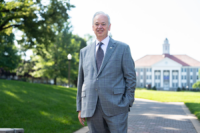JMU focuses on strengths for strategic planning
JMU President Jim Schmidt outlines plans to boost rural health care, expand nursing programs and strengthen civility on campus.
100 People to Meet in 2026: Showstoppers
From Arthur Ashe and Tiki Barber to Edgar Allan Poe and Missy Elliott, Virginia has cultivated athletics and the arts, a rich tradition that these leaders continue to promote.
JMU introduces next president
James Madison University on Wednesday announced that University of Wisconsin-Eau Claire Chancellor James C. Schmidt will be the next president of Virginia‘s fifth largest public university. The university’s board of visitors, who voted to affirm his appointment earlier in the day, announced Schmidt’s selection during a morning ceremony at the university’s Harrisonburg campu[...]
JMU receives $2.5M gift for new library wing
James Madison University has received a $2.5 million gift for the new wing of its Carrier Library. Alexandria residents Stan and Rosemary Jones provided the donation, which the Harrisonburg public university announced in late November. A 1954 physics and math alumnus of what was then Madison College, Stan worked for McLean-based Mitre as an engineer […]
Directory of business schools in Virginia
(Editor’s note: Listings with logos and longer descriptions are paid listings from display advertisers.) PUBLIC COLLEGES & UNIVERSITIES (nonprofit, based in Virginia) CHRISTOPHER NEWPORT UNIVERSITY Joseph W. Luter III School of Business Newport News cnu.edu/schoolofbusiness Business programs: Bachelor’s degrees in accounting, finance, management and marketing. Graduate: Master̵[...]
Va. universities take ‘heavy hand’ with protest policies, advocate says
RICHMOND, Va. — Students, lawmakers and free-speech activists question if updated university policies that regulate student demonstrations violate First Amendment rights. After campus protests that led to some clashes with police, institutions such as Virginia Commonwealth University, James Madison University, University of Virginia and Virginia Tech adopted similar policies. The new rules b[...]
A time of transition
Turns out, Charlie King isn’t a gone fishin’ sort of retiree. Back in 2021, King retired after serving as James Madison University’s chief financial officer and senior vice president of administration and finance for 25 years. King and his wife, Sherry, knew they wanted to stay in the area after retirement. Their son Garrett works […]
KPMG names D.C. area managing partner
Patrick Ryan has been named managing partner of Big Four accounting firm KPMG’s Washington, D.C.-area office, the company announced Thursday. In the role, Ryan will oversee more than 3,000 employees and also will be the firm’s U.S. federal business leader and sector leader. He succeeds Tim Gillis, who is retiring Sept. 30 after 26 years […]
Alger leaving JMU to head American University
American University announced Monday that James Madison University President Jonathan Alger will be its next president, starting July 1. Alger joined the Harrisonburg public university in 2012. Alger will be the 16th president of AU, a private university in Washington, D.C., replacing President Sylvia Burwell. During his tenure, JMU received R2 research classification from the […]
Support system
James Madison University is where Angela Reddix says she found “my tribe, the godmothers of my children” — and also her future husband, Carl, whom she met on her first day on campus. “All those relationships came from JMU,” says Reddix, founder, president and CEO of Norfolk-based ARDX, a health care management and IT consulting […]
Education 2023: JONATHAN R. ALGER
Alger, who joined JMU in 2012, has led the public university to new heights. In the past two years, the university received R2 research classification from the Carnegie Commission on Higher Education, joined the Sun Belt Conference and the FBS level in NCAA Division I football, and saw the graduation of the first cohort from […]
Money machine
In 2009, Donald Hart found himself in an enviable position. Leading up to his graduation from Ocean Lakes High School in Virginia Beach, Hart had been accepted to a slew of the state’s public, four-year universities: Virginia Tech, the University of Virginia, Old Dominion University, George Mason University and James Madison University. Attracted by the […]





















